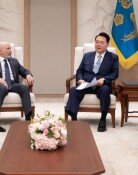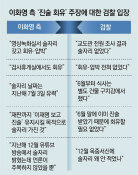As Ties Wane, So Does Taste for US Arms
As Ties Wane, So Does Taste for US Arms
Posted December. 01, 2005 03:22,
There has been a remarkable change in South Koreas principal arms import industry, historically monopolized by the United States. The preferential treatment that American military equipment has long enjoyed, derived from the Korean-American military alliance, will no longer exist.
The prospect of the diversification of Koreas arms imports is positive, but some are worried about its impact on ROK-U.S. Combined Forces Command operations.
On the 23rd of last month, Alexander Vershbow, the current American ambassador, met in person to talk with Yoon Kwang-ung, the head of the Ministry of National Defense and stated, We request that the South Korean government be impartial and objective in its assessment of airborne early warning and control systems. (AWACS) Further, he relayed the message from the American Department of Defense that AWACS compatibility between South Korean and United States forces is crucial.
Two trillion won has been invested in the AWACS competition, and presently the United Statess Boeings E-737 and Israels Eltas G-550 are competing for the AWACS contract. Boeings model has the advantage of a large fuselage and vastly superior radar capability, while Eltas model has the advantage of an inexpensive price.
The Ministry of Defense has already announced that if both systems meet all necessary requirements, that they will select the cheaper product. The ministrys plan to select the system by price, after thoroughly considering the capabilities and without consideration for the Korean-American alliance, demonstrates one aspect of the transformation of the relations between the two countries.
However, a section of the army is worried that implementing an AWACS system from a country other than the United States, will present difficulties to the efficiency and reciprocity of the ROK-U.S. Combined Forces Command in case of an emergency.
The case of the Korean Helicopter Project (KHP), in which a total of 5.4 trillion won has been invested and which has involved the French-Germany joint-venture company Eurocopter, leaving out the American Bell Helicopter company and the English-Italian joint-venture company IWIL, has been significant as well. One person related to the Ministry of Defense hammered home the point last month that, KHPs overseas business selection standards are price and capabilities, but technical aspects are foremost, and there are no special considerations for the Korean-American alliance or other political matters.
When compared to how, in April 2002, the government selected the American F-15K jet fighter over the French Dassault Rafale when purchasing new aircraft for the air force in its first ever military reinforcement project, a move seen as definitely favoring Korean-American military relations, Koreas recent shift reflects a huge change.
At the time, the Ministry of Defense announced, Since the capabilities of both machines fall within the requisite 3% error range, considering the Korean-American alliance, we decided to select the F-15K. Dassault was shocked by the decision, saying, The Rafale greatly outperforms the F-15K in its capabilities, but a mistake has been made and our bid has been rejected, and declared, Never again will we participate in competing for a bid in the territory of the American defense industry.
In July of the same year, the Ministry of Defense selected the AEGIS system from the American company Lockheed Martin as the electronic warfare system for its newest class of destroyers, the Third Experimental Korean Destroyer (KDX-III) program. At the time, the Netherlands company Thales objected that there is a lack of impartiality in this business, and left the market.
In only a few years, political consideration for American arms has vanished, and one army official stated, Ultimately, this is an undeniable reflection of how the Korean-American alliance and Korean-American military relations have subtly changed. He added, The political decision to diversify Korean arms imports away from mainly American products has had a great impact.
Sang-Ho Yun ysh1005@donga.com







